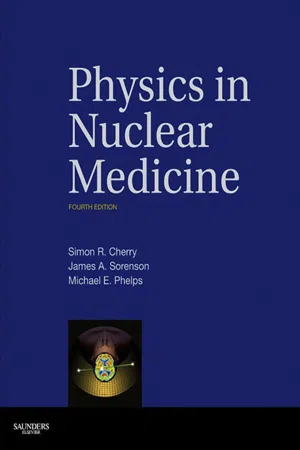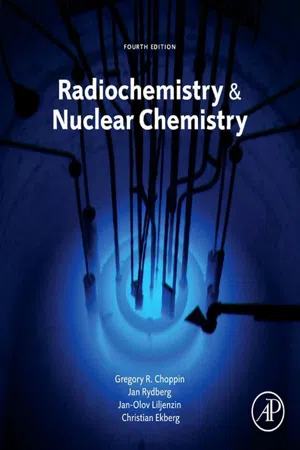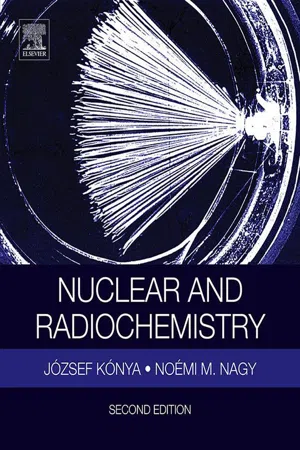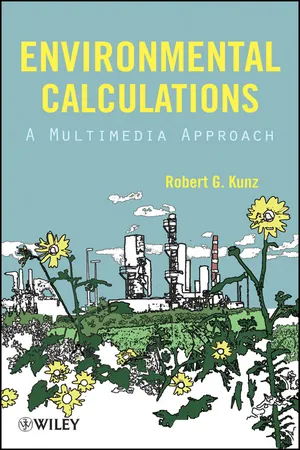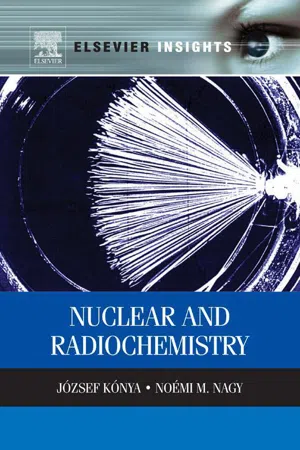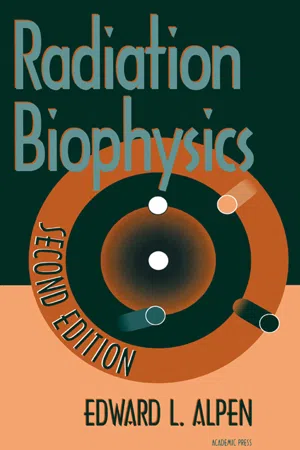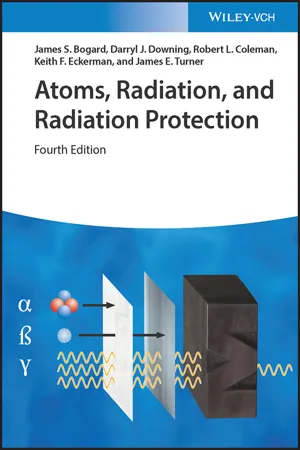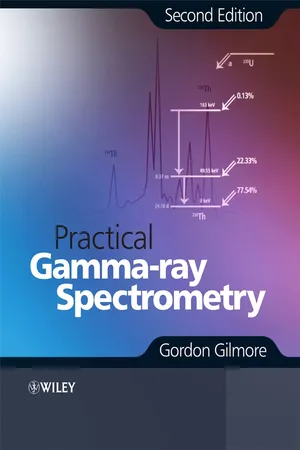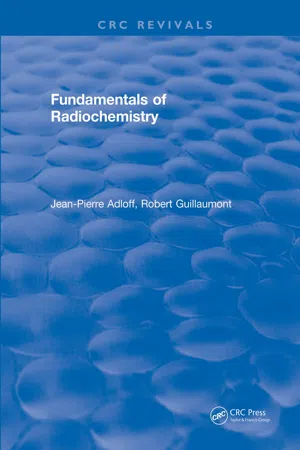Physics
Radioactive Decay
Radioactive decay is the process by which an unstable atomic nucleus loses energy by emitting radiation, such as alpha or beta particles, or gamma rays. This process results in the transformation of the original element into a different element or isotope. The rate of decay is characterized by the element's half-life, which is the time it takes for half of the radioactive atoms to decay.
Written by Perlego with AI-assistance
Related key terms
Related key terms
1 of 4
Related key terms
1 of 3
10 Key excerpts on "Radioactive Decay"
- eBook - ePub
- Simon R. Cherry, James A. Sorenson, Michael E. Phelps(Authors)
- 2012(Publication Date)
- Saunders(Publisher)
chapter 3Modes of Radioactive Decay
Radioactive Decay is a process in which an unstable nucleus transforms into a more stable one by emitting particles, photons, or both, releasing energy in the process. Atomic electrons may become involved in some types of Radioactive Decay, but it is basically a nuclear process caused by nuclear instability. In this chapter we discuss the general characteristics of various modes of Radioactive Decay and their general importance in nuclear medicine.a General Concepts
It is common terminology to call an unstable radioactive nucleus the parent and the more stable product nucleus the daughter . In many cases, the daughter also is radioactive and undergoes further Radioactive Decay. Radioactive Decay is spontaneous in that the exact moment at which a given nucleus will decay cannot be predicted, nor is it affected to any significant extent by events occurring outside the nucleus.Radioactive Decay results in the conversion of mass into energy. If all the products of a particular decay event were gathered together and weighed, they would be found to weigh less than the original radioactive atom. Usually, the energy arises from the conversion of nuclear mass, but in some decay modes, electron mass is converted into energy as well. The total mass-energy conversion amount is called the transition energy , sometimes designated Q .* Most of this energy is imparted as kinetic energy to emitted particles or converted to photons, with a small (usually insignificant) portion given as kinetic energy to the recoiling nucleus. Thus Radioactive Decay results not only in the transformation of one nuclear species into another but also in the transformation of mass into energy.Each radioactive nuclide has a set of characteristic properties. These properties include the mode of Radioactive Decay and type of emissions, the transition energy, and the average lifetime of a nucleus of the radionuclide before it undergoes Radioactive Decay. Because these basic properties are characteristic of the nuclide, it is common to refer to a radioactive species, such as 131 I, as a radionuclide . The term radioisotope also is used but, strictly speaking, should be used only when specifically identifying a member of an isotopic family as radioactive; for example, 131 - eBook - ePub
- Gregory Choppin, Jan-Olov Liljenzin, Jan Rydberg, Christian Ekberg(Authors)
- 2013(Publication Date)
- Academic Press(Publisher)
Chapter 5Unstable Nuclei and Radioactive Decay
Abstract
Radioactive Decay is a spontaneous nuclear transformation that has been shown to be unaffected by pressure, temperature, chemical form, etc (except a few very special cases). This insensitivity to extranuclear conditions allows us to characterize radioactive nuclei by their decay period and their mode and energy of decay without regard to their physical or chemical condition.Chapter OutlineKeywords
Radioactive Decay; Conservation laws; Alpha decay; Decay energy; Beta decay; Relativistic mass; Q -value; Gamma emission; Internal conversion; Spontaneous fission; Decay modes; Decay schemes; Curie unit; Transient equilibrium; Radioisotope generators; Heisenberg uncertainty principle5.1. Radioactive Decay 5.2. Conservation Laws 5.3. Alpha Decay 5.3.1. Detection 5.3.2. Decay energy 5.4. Beta Decay 5.4.1. Detection 5.4.2. The β-decay process 5.4.3. The neutrino 5.4.4. Double beta decay5.4.5. β− -Decay5.4.6. Positron decay 5.4.7. Electron capture 5.4.8. Daughter recoil 5.5. Gamma Emission and Internal Conversion 5.5.1. Gamma emission 5.5.2. Internal conversion 5.6. Spontaneous Fission 5.7. Rare Modes of Decay 5.8. Decay Schemes and Isotope Charts 5.9. Secondary Processes in the Atom 5.10. Closed Decay Energy Cycles 5.11. Kinetics of Simple Radioactive Decay 5.12. Mixed Decay 5.13. Radioactive Decay Units 5.14. Branching Decay 5.15. Successive Radioactive Decay 5.16. Radioisotope Generators 5.17. Decay Energy and Half-Life 5.18. The Heisenberg Uncertainty Principle 5.19. Exercises 5.20. Literature5.1 Radioactive Decay
Radioactive Decay is a spontaneous nuclear transformation that has been shown to be unaffected by pressure, temperature, chemical form, etc (except a few very special cases). This insensitivity to extranuclear conditions allows us to characterize radioactive nuclei by their decay period and their mode and energy of decay without regard to their physical or chemical condition. - eBook - ePub
- Jozsef Konya, Noemi M. Nagy(Authors)
- 2018(Publication Date)
- Elsevier(Publisher)
Chapter 4 Radioactive Decay Abstract In this chapter, the kinetics and mechanisms of Radioactive Decay will be discussed. The kinetics of the simple decay will be derived statistically. The basic terms and units of Radioactive Decay will be defined. The branching and successive decay will be discussed, including the different ratios of the decay constants of the parent and daughter nuclides and the radioactive equilibria. The Radioactive Decay series will be illustrated. The methods of radioactive dating using the kinetics and decay constants will be discussed. They perform dating on the basis of lead isotope ratios, lead-210 activity, helium concentration, fission tracks of uranium, potassium–argon, rubidium–strontium methods, and radiocarbon dating. The mechanism of the Radioactive Decay (namely, alpha decay, negative and positive beta decay, electron capture, double beta decay, proton and neutron decay, spontaneous fission, isomeric transition, and exotic decay) will be shown. The detection methods of neutrinos will be illustrated. Keywords Radioactive Decay; kinetics of Radioactive Decay; simple Radioactive Decay; branching Radioactive Decay; successive Radioactive Decay; radioactive equilibrium; radioactive dating; mechanism of Radioactive Decay; alpha decay; beta decays; isomeric transition As mentioned earlier (Section 2.1.1), the stability of a nucleus (as characterized by the binding energy) is determined by the ratio of protons to neutrons (see Eq. (2.10)). The binding energy of isobar nuclei as a function of proton–neutron ratio forms a parabola or parabolas (see Fig. 3.1), where those nuclei close to the minimum are stable while those farther away are undergoing Radioactive Decay in order to reach the optimal proton/neutron ratio - eBook - ePub
Environmental Calculations
A Multimedia Approach
- Robert G. Kunz(Author)
- 2011(Publication Date)
- Wiley-AIChE(Publisher)
Chapter 10 Radioactive Decay Unless you are a medical practitioner, it is not good to have a disease named after you. 10.1 DEFINITIONS AND UNITS 10.1.1 DefinitionsAs discussed in an earlier chapter, the nuclei of atoms are made up of protons and neutrons. The number of protons (the atomic number) determines the identity of the element; protons and neutrons together, collectively known as nucleons , determine the atomic mass number. Atoms containing the same number of protons but differing in the number of neutrons are known as isotopes [1–4].Not all isotopes are stable. Some will spontaneously decompose (over a period measured in fractions of a second to many, many years) by emitting material and ionizing radiation in an attempt to achieve stability. The emitting, or parent, nucleus undergoes a transmutation into the nucleus of a different element. The element is called the daughter species or decay product . This process is termed radioactivity or Radioactive Decay and the unstable isotopes radionuclides or radioisotopes . Radioactivity arises from both natural and man-made sources.10.1.2 Units of Radioactive Decay and ExposureThe activity of a radioactive source is measured in curies (Ci), named after Madame Marie Curie and her husband Pierre Curie, Nobel Prize winners for their early work in radioactivity. The curie corresponds to 3.7 × 1010 radioactive disintegrations per second. It is the decay rate of 1 g of radium. Fractions of this unit, such as milli (10−3 ), pico (10−12 ), and others are also used. Other units of activity are the becquerel (Bq), one disintegration per second, and the TBq (1012 Bq). Becquerel, another pioneer in this field, shared the Nobel Prize for Physics in 1903 with the Curies [3, pp. 246–247; 4, pp. 1089–1090].The roentgen (R) (from Wilhelm Roentgen, the discoverer of X-rays in 1895) is a measure of the ability of a beam of X-rays or gamma rays to deliver energy to a given material. For example, a dental X-ray can provide an exposure of 300 mR/s, with 1 R corresponding to the deposition of 93.3 × 10−7 J of energy per gram of tissue or 87.8 × 10−7 - eBook - ePub
- Jozsef Konya, Noemi M. Nagy(Authors)
- 2012(Publication Date)
- Elsevier(Publisher)
4
Radioactive Decay
As mentioned earlier (Section 2.1.1 ), the stability of a nucleus (as characterized by the binding energy) is determined by the ratio of protons to neutrons (see Eq. (2.10) ). The binding energy of isobar nuclei as a function of proton–neutron ratio forms a parabola or parabolas (see Figure 3.1 ), where those nuclei close to the minimum are stable while those farther away are undergoing Radioactive Decay in order to reach the optimal proton/neutron ratio. The Radioactive Decay is a random process for the individual nucleus so as to describe the kinetics of Radioactive Decay, a statistical approach has to be applied.4.1 Kinetics of Radioactive Decay
4.1.1 Statistics of Simple Radioactive Decay
Let us consider that the probability of the decomposition of a radioactive nuclide in a Δt time interval is p :(4.1)where λ is a factor of proportionality. The probability of the process that the nuclide does not decompose in Δt is:(4.2)The probability that the nuclide does not decompose in another second, third, or more Δt interval can also be defined by Eq. (4.2) . The probability that the nuclide does not decompose in the 2×Δt interval is:(4.3)The probability that the nuclide does not decompose in n ×Δt is:(4.4)Let us divide the total time of the observation (t ) into n intervals:(4.5)Substituting Eq. (4.5) into Eq. (4.4) , we obtain:(4.6)At n →∞:(4.7)When the initial number of the radioactive nuclides is N 0 , the number of nuclides that do not undergo radioactive decomposing during t time (N ) is:(4.8)Equation (4.8) describes the kinetics of the simple Radioactive Decay, i.e., the Radioactive Decay law, where λ is the decay constant. The value of the decay constant characterizes the radionuclide; thus, it is independent of physical and chemical conditions (pressure, temperature, chemical environment, etc.).As seen in Eq. (4.8) , the Radioactive Decay has first-order kinetics, having all characteristics of first-order reactions. It has a well-defined half-life (t 1/2 - eBook - ePub
- Edward L. Alpen(Author)
- 1997(Publication Date)
- Academic Press(Publisher)
The unit of radioactivity (becquerel) measures only the rate of nuclear transformations and does not deal with the kinetic energy released in the process. The reader is cautioned to observe that disintegration rate is the number of radioactive nuclei undergoing decay per unit of time. The number and kind of emissions are not specified. Whether one emission accompanies a disintegration or whether four emissions result from a single disintegration, it is counted as a single event for the determination of activity.LAW OF Radioactive Decay
The probability with which a radionuclide decays is, with one trivial exception, a characteristic and immutable constant associated with a particular radionuclide, and this probability cannot be influenced by ambient conditions or their variation. The trivial exception is that tritium gas under very extreme pressures is shown to decrease slightly its decay rate.The decay constant (or transformation constant) λ is the probability of decay of a single radioactive atom per unit of time and is related to the rate of disintegration and the number of radioactive atoms present as(3.1)N is the number of atoms of the radionuclide in the source and t is the time (expressed in whatever unit is compatible with the decay constant). Integration of Eq. (3.1) yields(3.2)N 0 is the initial number of radioactive atoms in the source, e is the natural base of logarithms, and N is the number of radioactive atoms present at any time t . If we let N = N 0 /2 and t = T (where T is taken to be the time required for a source to decrease its activity to N 0 /2), substitution into Eq. (3.2) gives, on rearrangement,(3.3)T is known as the half-life or the half-time and is conveniently measured from the linear semilogarithmic graphic plot of the number of radioactive atoms remaining as a function of time.DEFINITION OF ACTIVITY
The quantity −dN/dt - eBook - ePub
- James S. Bogard, Darryl J. Downing, Robert L. Coleman, Keith F. Eckerman, James E. Turner(Authors)
- 2022(Publication Date)
- Wiley-VCH(Publisher)
Chapter 4 treats radioactive transformations, serial decay, and naturally occurring radioactivity.]- 4 Evans, R. D.,
The Atomic Nucleus, McGraw-Hill, New York, NY (1955). [Chapter 15 describes serial decay, decay schemes, equilibrium, and other topics.]- 5 Faw, R. E., and Shultis, J. K.,
Radiological Assessment, Prentice-Hall, Englewood Cliffs, NJ (1993). [Chapter 4 gives and excellent coverage of exposure to natural sources of radiation, including radon.]- 6 Magill, Joseph, and Galy, Jean,
Radioactivity-Radionuclides-Radiation, Springer Verlag, New York, NY (2005). [This book discusses a number of environmental and human radiological health issues. It contains extensive nuclear data. A CD-ROM is included.]- 7 National Research Council,
Health Risks of Radon and Other Internally Deposited Alpha-Emitters: BEIR IV, National Academy Press, Washington, DC (1988). [A comprehensive report (602 pp.) from the Committee on the Biological Effects of Ionizing Radiation.]- 8 Nazaroff, W. W., and Nero, A. V., Jr. eds.,
Radon and its Decay Products in Indoor Air, Wiley, New York, NY (1988).- 9 NCRP Report No. 97,
Measurement of Radon and Radon Daughters in Air, National Council on Radiation Protection and Measurements, Bethesda, MD (1988). [Contains basic data on the three natural decay series and characteristics of radon daughters discussed here. Main emphasis of the Report is on measurements.]- 10 NCRP Report No. 103,
Control of Radon in Houses, National Council on Radiation Protection and Measurements, Bethesda, MD (1989).4.8 Problems
- 4.1 What is the value of the decay constant of 40 K?
- 4.2 What is the decay constant of tritium?
- 4.3 The activity of a radioisotope is found to decrease by 30% in 1 wk. What are the values of its
- decay constant
- half-life
- mean life?
- eBook - ePub
Nuclear Engineering Fundamentals
A Practical Perspective
- Robert E. Masterson(Author)
- 2017(Publication Date)
- CRC Press(Publisher)
Figure 6.11 shows the distribution of kinetic energies of a number of alpha particles emitted from the decay of a typical heavy nucleus. Notice that the peak of the distribution in this case is about 5 MeV, and very few alpha particles are emitted with energies greater than 7 MeV or less than 2 MeV. This is due to the fact that the binding energy of an alpha particle is very similar from one heavy element to the next.FIGURE 6.11 A typical alpha particle energy spectrum resulting from the decay of a radioactive material.6.10 Physics of Beta Decay
When a uranium, a plutonium, or a thorium atom splits into smaller parts of intermediate atomic weight, the remaining fission fragments can sometimes have more neutrons than the ideal neutron to proton ratio that they need to remain stable over a long period of time, which is about 1.5 to 1. Any fission fragment or fission product that has this characteristic is said in the nuclear trade to be “neutron rich. ” When this happens, the easiest way for a nucleus to transition itself into a stable energy state is to convert one of the extra neutrons inside the nucleus to a proton and to emit an electron and a neutrino in the process. This interesting combination of events usually happens within a minute of the time that the parent nucleus splits apart, and it is usually followed up by a similar process in either the parent or the children that can occur over the time frame of several days, months, or even years. This process always involves three particles as the by-products (a proton, a neutrino, and an electron) and always conserves energy, momentum, and charge (see Figure 6.12 ). Collectively, this combination of these events results in a process that is known as radioactive beta decay or β− decay. The governing equation for this reaction is(β− decay)n → p +e −+v e( 6.14 )where n, p, e− , and νe are the symbols for the neutron, the proton, the electron, and the neutrino, respectively. While this process is extremely common in spent nuclear fuel, there is another type of beta decay that occurs quite frequently in the cores of very large stars but not very often in operating nuclear reactors, per se. This process occurs when the nucleus of an atom has an excess of protons - eBook - ePub
- Gordon Gilmore(Author)
- 2011(Publication Date)
- Wiley(Publisher)
1 Radioactive Decay and the Origin of Gamma and X-Radiation 1.1 INTRODUCTIONIn this chapter I intend to show how a basic understanding of simple decay schemes, and of the role gamma radiation plays in these, can help in identifying radioactive nuclides and in correctly measuring quantities of such nuclides. In doing so, I need to introduce some elementary concepts of nuclear stability and Radioactive Decay. X-radiation can be detected by using the same or similar equipment and I will also discuss the origin of X-rays in decay processes and the light that this knowledge sheds on characterization procedures.I will show how the Karlsruhe Chart of the Nuclides can be of help in predicting or confirming the identity of radionuclides, being useful both for the modest amount of nuclear data it contains and for the ease with which generic information as to the type of nuclide expected can be seen.First, I will briefly look at the nucleus and nuclear stability. I will consider a nucleus simply as an assembly of uncharged neutrons and positively charged protons; both of these are called nucleons.Z is the atomic number, and defines the element. In the neutral atom, Z will also be the number of extranuclear electrons in their atomic orbitals. An element has a fixed Z , but in general will be a mixture of atoms with different masses, depending on how many neutrons are present in each nucleus. The total number of nucleons is called the mass number.A, N and Z are all integers by definition. In practice, a neutron has a very similar mass to a proton and so there is a real physical justification for this usage. In general, an assembly of nucleons, with its associated electrons, should be referred to as a nuclide. Conventionally, a nuclide of atomic number Z , and mass number A is specified as , where Sy is the chemical symbol of the element. (This format could be said to allow the physics to be defined before the symbol and leave room for chemical information to follow; for example, Co2+ .) Thus, is a nuclide with 27 protons and 31 neutrons. Because the chemical symbol uniquely identifies the element, unless there is a particular reason for including it, the atomic number as subscript is usually omitted - as in 58 Co. As it happens, this particular nuclide is radioactive and could, in order to impart that extra item of knowledge, be referred to as a radionuclide. Unfortunately, in the world outside of physics and radiochemistry, the word isotope has become synonymous with radionuclide - something dangerous and unpleasant. In fact, isotopes are simply atoms of the same element (i.e. same Z , different N ) - radioactive or not. Thus and are isotopes of cobalt. Here 27 is the atomic number, and 58, 59 and 60 are mass numbers, equal to the total number of nucleons. 59 - eBook - ePub
- Jean-Pierre Adloff(Author)
- 2018(Publication Date)
- CRC Press(Publisher)
In the vast majority of cases, only relative activities are measured. An appropriate detector delivers a number of pulses proportional to the activity, and hence to the number of disintegrations per unit time:N( pulses per s )= η kN( disintegrations per s )The proportionality factor η represents the overall detection efficiency, which includes the intensity of the detected radiations with respect to all possible decay modes and the geometry of the source-detector assembly. The factor k is related to the intrinsic properties of the detector (see Chapter 5 ). The constancy of the factor η is a prerequisite in any radiochemical experiment and must be checked regularly.V Decay Schemes
The properties of radionuclides and those of the emitted radiations can be summarized in an illustrative representation, the decay scheme of the nuclide. The schemes of the lightest elements are relatively simple, but may be very complex for heavy nuclides.The scheme comprises the ground state of a stable or radioactive nuclide and all known excited states with their characteristics including energy or mass with respect to the ground state, spin, parity, lifetime, and frequently the electric quadrupolar and magnetic dipolar momenta. The various observed transitions between the levels are indicated.The nature and properties of the radiations emitted in the transition from an initial to a final level are derived from the properties of the states. The total decay energy Q, in MeV, from the ground state of the parent nuclide to the ground state of the daughter is indicated in the scheme, together with all pathways which populate the various levels.A γ Emission and Internal Conversion
With very few exceptions, all radionuclides undergo de-excitation with the emission of γ radiations. The transition to a lower state by emission of a nucleon is possible if the excitation energy exceeds the binding energy of a neutron or a proton, which amounts to about 8 MeV. This is very common in nuclear reactions, but is observed only rarely in Radioactive Decays.
Index pages curate the most relevant extracts from our library of academic textbooks. They’ve been created using an in-house natural language model (NLM), each adding context and meaning to key research topics.
Explore more topic indexes
Explore more topic indexes
1 of 6
Explore more topic indexes
1 of 4
